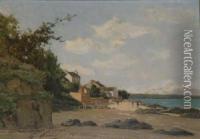Georges Perrot Paintings
Georges Perrot was a French archaeologist and art historian, born on November 12, 1832, in Valognes, France. His contributions to the field of archaeology and art history were significant, particularly in the study of ancient Greek art and architecture. He was also known for his role in the development of archaeological methodology and for his influential writings.
Perrot's academic career was distinguished and prolific. He studied at the prestigious École Normale Supérieure in Paris, where he later became a professor of Greek language and literature. His interest in archaeology and ancient cultures was not just theoretical but also practical, as he participated in various archaeological expeditions. One of his major contributions to the field was his collaboration with Charles Chipiez on a comprehensive multi-volume work titled 'Histoire de l'Art dans l'Antiquité' (History of Art in Antiquity), which became a fundamental resource for students of ancient art and architecture.
Throughout his career, Perrot endeavored to understand the aesthetic principles of ancient civilizations and to place art and architecture within their historical and cultural contexts. His work helped to establish the academic discipline of art history as distinct from archaeology, emphasizing the importance of stylistic development and artistic expression as a reflection of societal values and beliefs.
In addition to his scholarly work, Perrot was involved in public service. He was the director of the French School at Athens for a period, which played a key role in excavations and research in Greece, and he contributed to the development of archaeological techniques and practices. Perrot's influence extended beyond his own research and teaching; he impacted the next generation of archaeologists and art historians through his academic positions and publications.
Georges Perrot died on June 30, 1914, leaving behind a legacy as a pioneer in the field of art history, particularly in the understanding of Greek antiquity. His work continues to be a reference for scholars and enthusiasts of ancient art and architecture.
